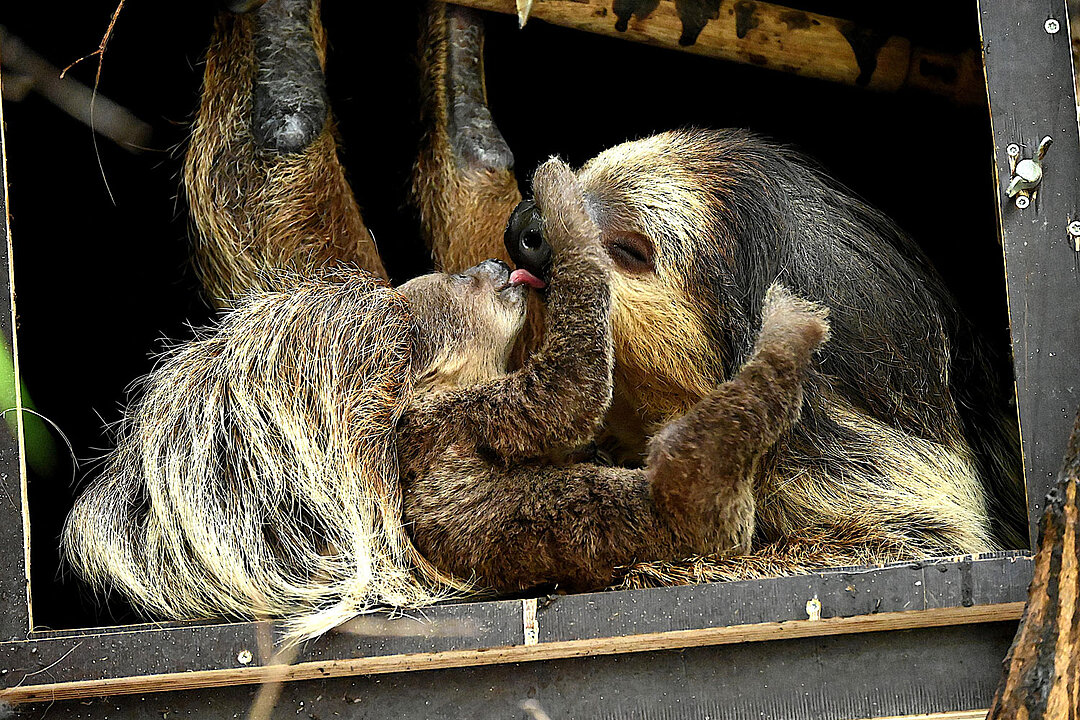![[Translate to English:] Faultier Jungtier](/fileadmin/_processed_/6/7/csm_tierpark-hellabrunn-faultier-nachwuchs-weibchen_34c23313e1.jpg)
Almost one year after the birth of the baby two-toed sloth at Hellabrunn Zoo, the sex of the infant has finally been confirmed: It’s a girl!
Her name is Wyona. Since coming into the world, Wyona has been glued to her protective mum. However, recently she has begun to gradually explore the sloth tree in the Rhino House on her own. During one of these first forays, a hair sample was taken to confirm the youngster’s gender. Patience is always required after the birth of a two-toed sloth to find out whether the baby is a boy or girl. It is almost impossible to determine the gender by external characteristics. Now that the youngster is moving around independently, this has allowed the zoo to collect the required hair sample and send it to a specialist laboratory. With the weaning process complete, Wyona is slowly making the transition to moving between the branches and ropes without her mum.
The discovery of slowness
Two-toed sloths can mate all year round. However, for many populations breeding is seasonal, with the mating season beginning at the start of the dry season in the tropical rainforests of South America. This particular species has a gestation period of ten to eleven months, after which the mother usually gives birth to a single young. A newborn is typically around 21 to 25 cm long and weighs between 360 and 450 grams at birth. For the first few weeks of life, it clings to the mother's stomach to nurse and begins to sample solid foods at about five weeks. Young sloths may continue to nurse for up to five months before gradually becoming independent at six to nine months old. However, this phase varies greatly and can sometimes last up to two years.
The baby sloth born at Hellabrunn Zoo is her parent’s third offspring. “So far, the mum seems to be doing a great job in taking care of her little one. The youngster is now moving around on its own and we were able to obtain the hair sample we needed,” says Carsten Zehrer, curator and head of zoology at Hellabrunn Zoo. “We are pleased that the young female will soon be even more active than before. This will give our visitors an opportunity to see our sloth family 'in action', especially in the morning and late afternoon."
Adapted to life in the tree
Two-toed sloths have several adaptations that enable their unique upside-down arboreal lifestyle. For example, their body hair runs from the belly to the back to allow rainwater to easily drain off when hanging upside-down. Sloths also have less muscle mass than other mammals and a very slow metabolic rate, which means they need to be adept at conserving energy. They do this by moving very slowly: a two-toed sloth can reach a speed of eight to ten metres per minute when hanging in a tree.
Zoo director Rasem Baban is delighted that the baby sloth’s gender has finally been revealed: "Our top priority is to ensure that the offspring is developing well and we have certainly been able to observe this in the past few months. Mum and baby have been inseparable, quite literally, which is always a very good sign for us. With the sloth family in the Rhino House, we would like to educate our visitors about the threats the animals face in the wild due to deforestation and habitat loss, and with Wyona we have one more ambassador to raise awareness about the precarious situation of the animals in South America."
